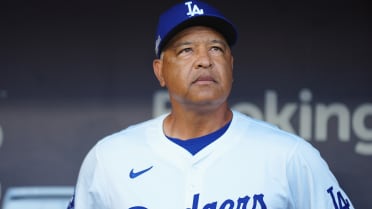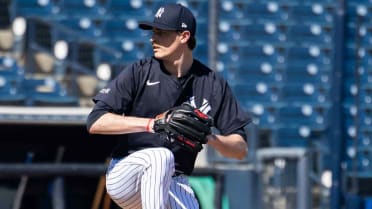Prospects with the best fastballs -- 1 for each team
Not all fastballs are created equal.
Sure, we all look at radar gun readings and it’s natural to ooh and ahh when we see triple digits. But we all know that just throwing hard does not necessarily equal having the best fastball in the organization.
There’s no doubt that the 30 pitchers listed below all can throw plenty hard enough, but when picking the best fastball for each system, we looked at things beyond velocity. Having good command of the heater, high spin rates, things like movement/life, all were taken into consideration when coming up with this list.
AMERICAN LEAGUE EAST
Blue Jays: Yosver Zulueta, RHP (No. 19)
Since the graduation of Nate Pearson, the 24-year-old Zulueta has taken over the mantle of most electric fastball in the Jays system when he’s healthy. That’s a big “when.” The right-hander faced only one batter in 2021 before suffering a torn ACL, thus ending his season. He returned to Minor League play on April 28 this season and has been averaging 96.5 mph on the fastball through his first two outings with Single-A Dunedin while touching 99 on the Statcast radar gun. Eight of his 10 whiffs in his May 5 outing came on the heater, so it (like him) certainly seems back.
Orioles: Grayson Rodriguez, RHP (No. 2/MLB No. 6)
A tip of the cap goes to reliever Felix Bautista, who was recently up to around 102 mph, but remember, we’re going with best overall fastball. He’s been up to triple digits in the past, and has averaged 94 mph, up to 98 so far this year (it’s early). But it’s much, much better than the radar gun readings because of the high spin rates, the plus life and the fact he commands it so well.
Rays: Shane Baz, RHP (No. 1/MLB No. 12)
Fastballs with an 80 grade are typically reserved for those with max velo. Baz certainly has some of that. What puts the right-hander’s fastball over the top is its perception of rise. Baz was one of only 12 pitchers in the Majors with a fastball that averaged at least 97 mph and 11.4 inches or less of vertical movement. So not only does it come in fast, it comes in higher than hitters expect, leading to a good amount of whiffs at all levels. We’ll see where Baz is at soon after he returns from the season-delaying elbow surgery to remove loose bodies he underwent earlier this spring, but there is good news in that he started live BP this week.
Red Sox: Frank German, RHP (No. 29)
German worked in the low 90s at North Florida before the Yankees made him a fourth-round pick in 2018, and they helped him boost his velocity to the mid-90s. Sent to the Red Sox as part of the Adam Ottavino salary dump in January 2021 and shifted to relief late last season, he's now sitting at 96-98 mph and touching 99 in Double-A, where he has allowed just three baserunners and one unearned run while striking out 15 in eight innings.
Yankees: Luis Medina, RHP (No. 12)
Medina's fastball first reached triple digits in June 2015, a month before he signed for $280,000 out of the Dominican Republic. He operates in the upper 90s, has hit 103 mph and also can unleash a well above-average curveball and changeup at times, but he never has provided consistent strikes. He sports a 3.60 ERA with 18 strikeouts in 15 innings through five Double-A starts.
AMERICAN LEAGUE CENTRAL
Guardians: Daniel Espino, RHP (No. 2/MLB No. 51)
Espino had the best high school fastball in the 2019 Draft, which prompted the Guardians to draft him 24th overall. He now parks in the mid- to upper 90s and tops out at 103 mph, backs up his heat with a pair of power breaking balls and has become one of the best pitching prospects in the game. He posted a 2.45 ERA and 35/4 K/BB ratio in 18 1/3 innings in his first four Double-A starts before going on the injured list with tendinitis in his right knee.
Royals: Nathan Webb, RHP (No. 29)
Dylan Coleman has officially graduated, so let’s slide in Webb. The 2016 34th-rounder has a great backstory in that he actually worked on the Royals’ grounds crew in high school and is now on the organization’s 40-man roster, in part because of the strength of the fastball. Webb touched 100 at times late last season and was typically sitting in the upper-90s -- velocity that helped earn him a 3.94 ERA, 1.03 WHIP and 89 strikeouts in 59 1/3 innings at Single-A and High-A. The Royals didn’t want to risk losing him in the Rule 5 Draft (that didn’t happen), so onto the 40-man he went -- one step closer to gaining a different entry to Kauffman Stadium.
Tigers: Angel De Jesus, RHP (No. 27)
We gave De Jesus’ fastball a 65 grade coming into the season, and like others here, that wasn’t just based on velocity. Sure, he sat mid-90s last season as a reliever at Double-A and Triple-A and flashed that a little bit in a two-inning MLB stint back on April 23. But the pitch features such sink that it can be tough for hitters to barrel too. Case in point: De Jesus has a 46 percent groundball rate at Triple-A over the last two years. That combo of velo and movement makes De Jesus’ fastball a potential weapon out of the bullpen.
Twins: Jhoan Duran, RHP (No. 5)
There’s a reason why Duran is starting to get some save opportunities and why we think he should be the Twins’ closer. A lot of it has to do with his heater, which has AVERAGED just over 100 mph and has elicited a whiff rate of 38.5 percent, according to Statcast. Big league hitters have managed just a .105 batting average against it so far this year.
White Sox: Norge Vera, RHP (No. 5)
The son of former Cuban pitching star Norge Luis Vera, Norge signed for $1.5 million as the top pitching prospect in the 2020-21 international class and operated with a 95-100 mph fastball during his pro debut last summer. He has yet to pitch in a game this year after straining his lat during the spring, but he should surface in Single-A in the near future.
AMERICAN LEAGUE WEST
A’s: Ryan Cusick, RHP (No. 8)
The Braves’ first-round pick in 2021, Cusick headed to the A’s organization as part of the Matt Olson blockbuster. The Wake Forest product has struggled with command both within and outside of the strike zone thus far, but he did bring a fastball in the 95-100 mph range with high spin and riding life, a reason why he’s still striking out 11.9 batters per nine so far this year.
Angels: Sam Bachman, RHP (No. 1)
The Angels were abundantly cautious in bringing Bachman off the injured list after back spasms shelved him this spring and he tossed three shutout innings in his 2022 debut up in Double-A on May 6. His fastball tends to sit in the mid-to-upper 90s and has touched triple digits with armside run and sink that helped him strike out 11.3 per nine during his career at Miami of Ohio.
Astros: Hunter Brown, RHP (No. 3)
Brown not only throws hard but also maintains his velocity over the course of a game and a season, working in the mid-90s and touching 99 mph with riding action on his four-seam fastball last September at the end of his first full year in the Minors. A 2019 fifth-round pick out of NCAA Division II Wayne State (Mich.), he has a 2.63 ERA with 35 strikeouts in 24 Triple-A innings.
Mariners: George Kirby, RHP (No. 3/MLB No. 30)
Kirby’s fastball sat in the low-90s when he came out of Elon University as a first-rounder in the 2019 Draft, but it’s now a heater that flirts with 100 mph. In his big league debut, when he threw six shutout innings, his fastball averaged 95.8 mph and topped out at around 99 mph. He gave up just one hit off the fastball (.083 BAA) and produced a 48.1 percent whiff rate with the pitch, which plays up even more because of his pinpoint command.
Rangers: Jack Leiter, RHP (No. 1/MLB No. 17)
Leiter's 90-97 mph fastball plays as an elite pitch not because of its velocity but rather its outstanding induced vertical break and riding life, which makes his heater almost impossible to barrel up in the zone. The No. 2 overall pick out of Vanderbilt last July and the son of two-time All-Star Al Leiter, he has posted a 1.93 ERA with 24 strikeouts in 18 2/3 innings during his pro debut in Double-A.
NATIONAL LEAGUE EAST
Braves: Spencer Strider, RHP (No. 2)
Strider has certainly put 2019 Tommy John surgery far in his rearview mirror while establishing himself as a very valuable member of the big league bullpen. Whether he stays in that role long-term or gets a chance to start, it’s clear his fastball will play at this level, averaging 98.5 mph so far this year, topping out at 100 mph. He’s gotten a whiff rate north of 30 percent and a .174 BAA with the pitch.
Marlins: Eury Pérez, RHP (No. 4/MLB No. 39)
Pérez had a mid-80s fastball when the Marlins first scouted him, but he has added four inches and 45 pounds since signing for $200,000 out of the Dominican Republic in 2019 and now deals at 93-98 mph with quality shape, induced vertical break and running action. Just 19 and already in Double-A, he has a 4.76 ERA with a 36/7 K/BB ratio in 22 2/3 innings.
Mets: Michel Otanez, RHP
We’ve always known about Otanez’s high-velocity heat, and it’s certainly returned in 2022. Now with Double-A Binghamton, the 24-year-old right-hander has regularly cranked it up to triple-digits out of the Rumble Ponies bullpen, where he has four saves, a 1.74 ERA and 13 strikeouts through 10 1/3 innings. The trouble with Otanez was he didn’t always know where the fastball was going. He walked 41 batters in 40 1/3 frames last year at High-A Brooklyn. He’s issued only two free passes through a small sample this season, and early returns indicate he has been much-improved when it comes to command. He’s worth following the deeper we get into May and June because the fastball gives him a shot at the Majors.
Nationals: Cade Cavalli, RHP (No. 1/MLB No. 37)
Cavalli was one of the hardest throwers at last year’s All-Star Futures Game, where he touched triple-digits three times, and he’s been back to sitting in the upper-90s at times this spring, giving Washington fans dreams of him leading the rotation someday. Unfortunately, Cavalli’s command has remained spotty, and the 6-foot-4 right-hander has yet to settle into a groove at Triple-A Rochester. He owns a 7.36 ERA with 19 strikeouts and 11 walks through 22 innings with the Red Wings -- numbers that delay a potential callup. The electric stuff is still there, and if Cavalli can hit his targets with some regularity, that opportunity in the capital will arrive.
Phillies: Mick Abel, RHP (No. 2/MLB No. 79)
The Phillies’ 2020 first-round pick struggled with his control during his first full season in 2021, but he still struck out 13.3 per nine in Low-A. He’s cranked that up to 14.5 per nine so far with the move up to the High-A South Atlantic League this year and a lot has to do with his fastball, which sits in the mid-90s and easily touches the upper-90s, thrown with tremendous arm speed and downhill from his 6-foot-5 frame.
NATIONAL LEAGUE CENTRAL
Brewers: Abner Uribe, RHP (No. 19)
It’s going to be a bit until we see Uribe’s fastball. The 21-year-old right-hander underwent season-ending left knee surgery on April 26 to address a torn meniscus. When he was on the mound, Uribe would post outings when he would regularly sit around 100 mph, and that velocity caught the attention of Brewers brass this spring. Manager Craig Counsell noted that he thought Uribe could have helped Milwaukee’s bullpen at some point this year. That will have to wait until 2023, but Uribe’s triple-digit heater will always give him a shot at The Show.
Cardinals: Edwin Nunez, RHP (No. 28)
Last year, Nunez posted the 109 fastest pitches recorded by Single-A Palm Beach pitchers, as recorded by Statcast, and all 109 were between 98.2 and 101.1 mph. The 20-year-old right-hander is back in the Florida State League to begin 2022, and so are the crazy gun readings. He’s sitting 97-98 mph through his first two starts and topping out at 99.3. Like so many flamethrowers at his age, Nunez has a lot of room to grow with his command and control. Entering Wednesday, he’d issued 60 walks in 56 2/3 career Minor League innings. But so long as he keeps topping velo charts, he’s worth following in the St. Louis system.
Cubs: Brailyn Marquez, LHP (No. 10)
The recipient of the largest bonus ($600,000) of any left-hander in the 2015 international class, Marquez saw his fastball go from sitting at 91-93 mph in his U.S. debut in 2017 to 96-98 mph with a peak of 102 in his last full season two years later. He pitched just two-thirds of an inning in the big leagues during the pandemic shutdown in 2020, missed all of last year after testing positive for COVID-19 and coming down with a shoulder impingement and has yet to return this season after a second bout with COVID-19.
Pirates: Kyle Nicolas, RHP (No. 18)
The Pirates got Nicolas in the Jacob Stallings deal and the big right-hander might make that deal a really good one for Pittsburgh. He can reach back for 100+ mph in shorter stints and holds mid-90s heat deep into starts and it plays well with carry up in the zone and heavy sink when it’s down. He’s struck out nearly 10 per nine in Double-A so far and can throw his plus heater for strikes.
Reds: Hunter Greene, RHP (No. 1/MLB No. 21)
There’s definitely been a learning curve for Greene during his first taste of life in the big leagues, and much of that has to do with continued work to command his fastball. The velocity has always been there, averaging over 98 mph and often hitting triple digits, but he’s been getting too much of the zone and Major League hitters can barrel it up, a reason why he started leaning on his slider a bit more in his last start.
NATIONAL LEAGUE WEST
D-backs: Ryne Nelson, RHP (No. 5)
Nelson entered 2022 with a reputation as a 6-foot-3 right-hander with an upper-90s fastball that he leaned on heavily to fan 163 batters in 116 1/3 innings at High-A and Double-A last season. The velo hasn’t quite been there in the same way this time out at Triple-A Reno -- he’s been closer to the 93-94 mph range -- but it’s important to point out that even there, Nelson’s fastball shows so much ride up in the zone that it can still give batters fits. We’ll keep an eye out to see if the velocity returns as Nelson gets deeper into his first Triple-A season, but at least the pitch’s other traits make it still a plus pitch, to say the least.
Dodgers: Bobby Miller, RHP (No. 2/MLB No. 55)
A first-round pick from Louisville in 2020, Miller can work at 97-98 mph for several innings at a time and hit triple digits with riding action on his four-seam fastball and also mix in a heavy mid-90s two-seamer with sink. He famously whiffed Shohei Ohtani on a 100-mph heater in an April exhibition game and has recorded a 5.51 ERA with a 20/5 K/BB ratio in 16 1/3 Double-A innings.
Giants: Gregory Santos, RHP (No. 14)
Part of the Eduardo Núñez trade with the Red Sox in 2017, Santos kicked up his stuff a notch during instructional league in 2020 and had maintained it since becoming a full-time reliever the following season. He now sits at 97-99 mph and regularly reaches triple digits. He has posted a 4.15 ERA with 11 strikeouts in 13 Triple-A innings and retired all five hitters he faced in his first big league outing of 2022 last Thursday.
Padres: MacKenzie Gore, LHP (No. 4/MLB No. 83)
This might be one of the last times we can feature Gore on one of these prospects lists, so we’ll take advantage of that. After two years filled with struggles with his command and delivery, Gore looks like he’s locked in at last and used his new-and-improved mechanics to launch to the Majors this spring. The 23-year-old southpaw has averaged 95 mph with his fastball in the bigs and has leaned on it heavily early, throwing it 66.4 percent of the time through five starts. That velo ranks in the 75th percentile in MLB, and with that in hand, perhaps it’s no surprise that Gore has gone to the heater so much given his previous struggles with spotting his pitches. Establishing a baseline with the fastball has allowed the Padres starter to post a solid 2.42 ERA to this point.
Rockies: Riley Pint, RHP
What a comeback story this could be. Pint, the one time No. 4 overall pick and Top 100 prospect, had left the game completely due to a combination of injuries and struggles with throwing strikes. He’s in Double-A, finding the strike zone a bit more consistently (4.5 BB/9) while striking out 11.6. He still has the electric fastball, consistently up to 98-99 mph as he gets eased into high-leverage situations.



